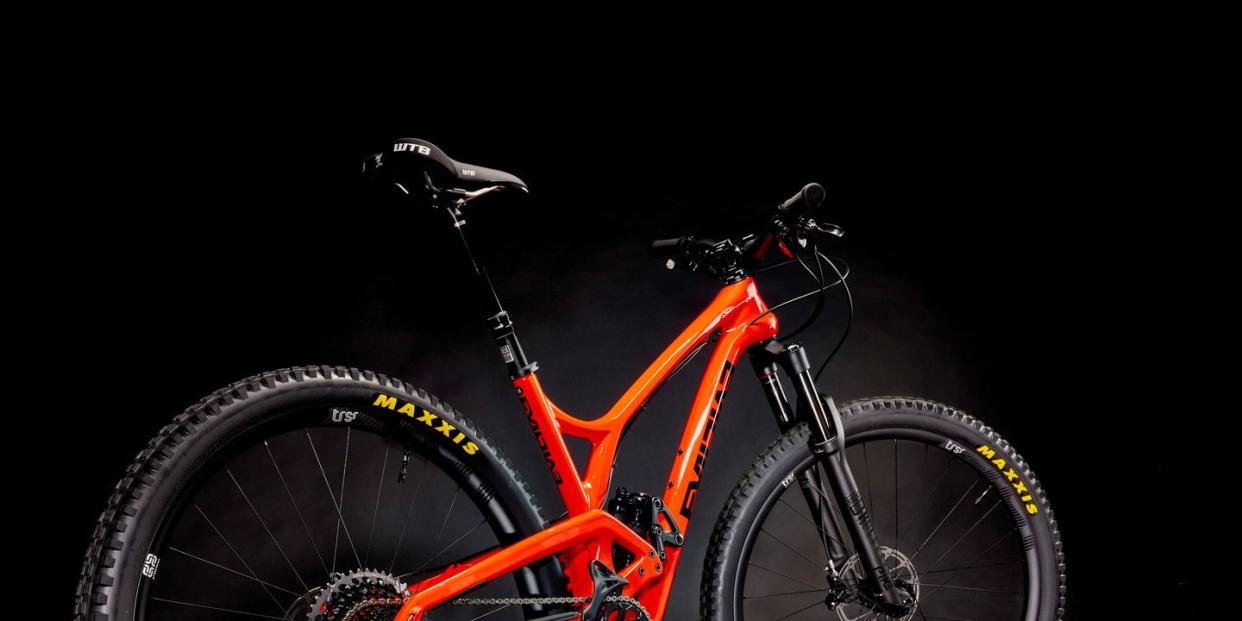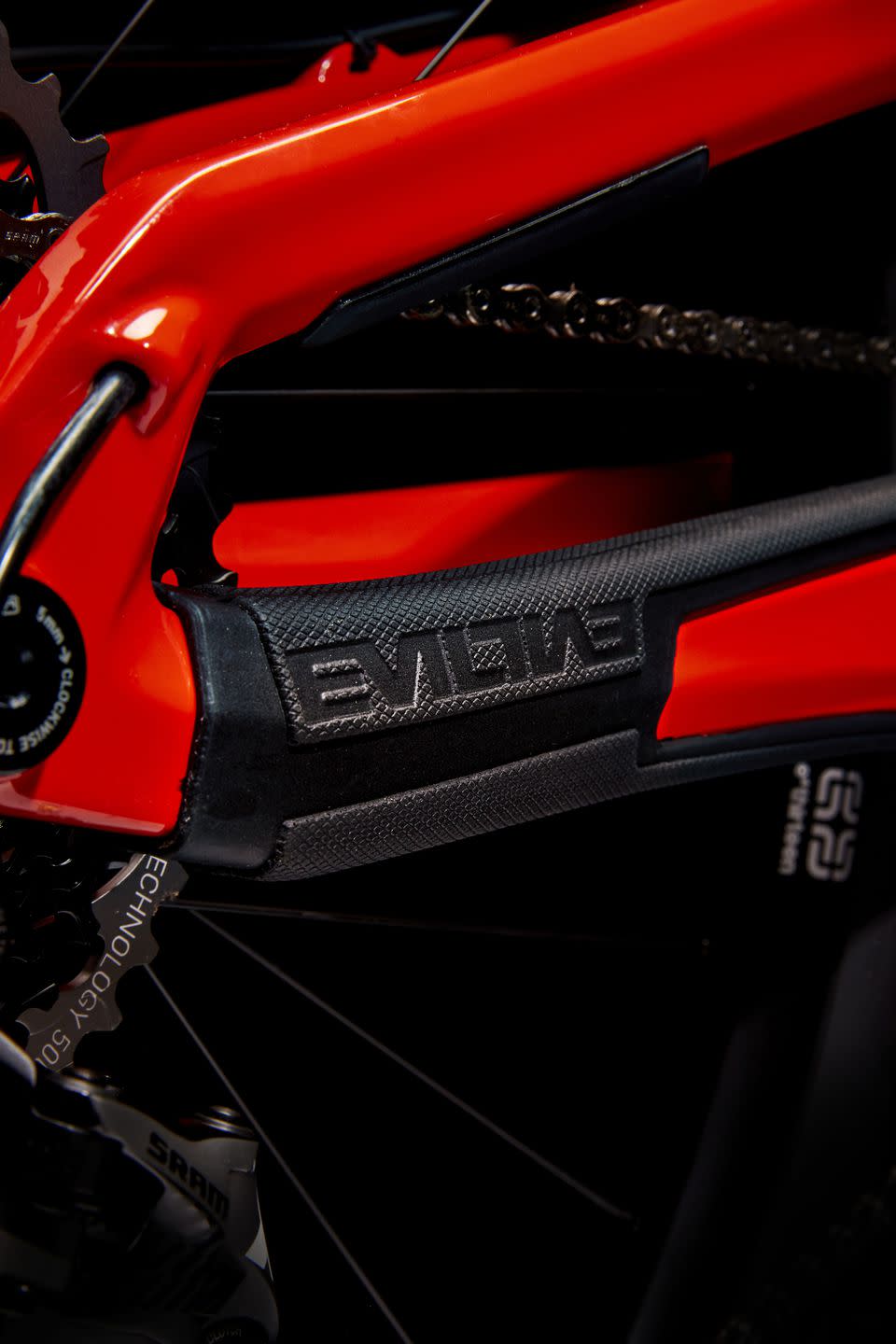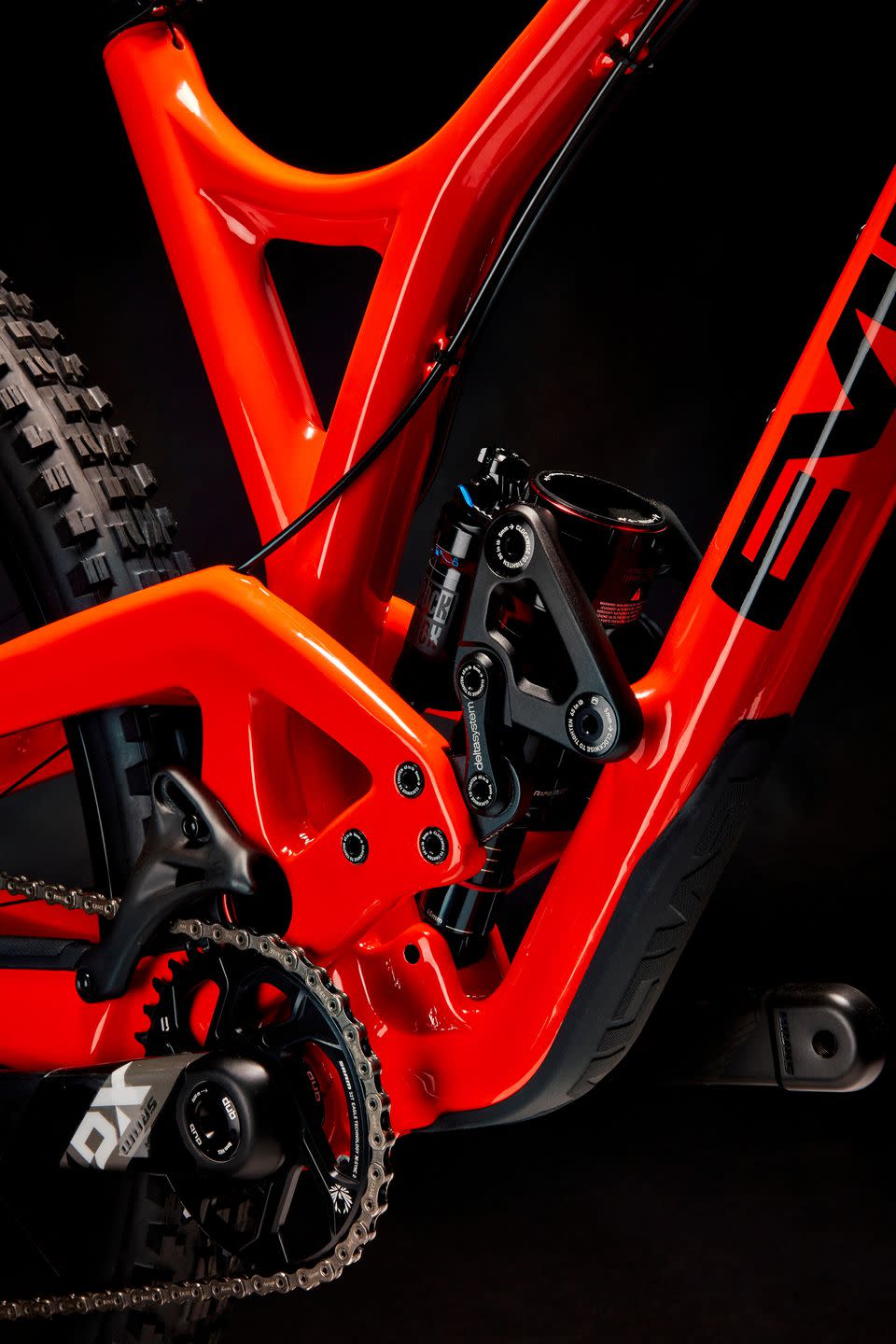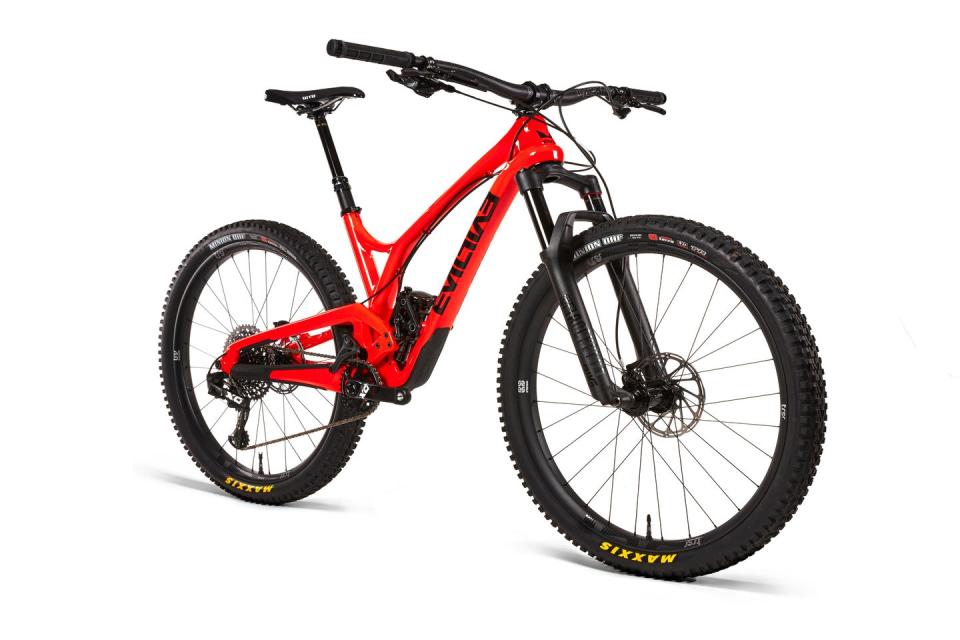Evil’s the Following MB Wants the Whole World to Huck

The most influential mountain bike of this century launched in late 2014. Almost no one noticed at first.
To be fair, Evil, the tiny brand behind it, barely had a pulse at the time. Originally founded by suspension guru Dave Weagle (creator of DW-Link) and later acquired by industry veteran Kevin Walsh, Evil, based out of Bellingham, Washington, had started out making downhill-oriented bikes in 2008, to much initial hype and acclaim. But defective frames and warranty issues plagued the company, and things went quiet for a long time.
So when Evil released The Following (now called The Following MB), there wasn’t a ton of press.
That changed quickly.
First off, this was one weird bike. It was short-travel-120mm-but it had, for its time, really long, low, and slack geometry. And it was a 29er. The 29ers then, like the Trek Fuel EX or the Santa Cruz Tallboy, were mostly fast and light and great for riding all day on-but not for shredding.
As people started riding The Following, buzz built. The feedback was universally positive. On this short-travel bike, people were riding DH, they were hucking. But they were also just having fun ripping around their everyday trails. And they were becoming 29er converts: Just when it seemed like 27.5 was going to win the wheel size war, The Following made 29ers cool. It dispelled the idea that they were slow to accelerate and hard to muscle around corners.
It’s impossible to quantify The Following’s total influence-mountain bikes were headed toward long-low-slack anyway. Still, today, almost every manufacturer has a trail bike that marries the playful, efficient feel of shorter travel with more aggressive geometry and parts. And one thing is inarguable: This bike saved Evil.
Bicycling sat down with Kevin Walsh and Dave Weagle and asked them to give us the gritty details of how their now-thriving company almost died, how The Following resurrected it, and what makes this bike ride like nothing else.
I. “The brand was on its knees.”
Bicycling: Where did The Following come from?
Kevin: Dave and I had met through Iron Horse.(1) They went through…what would you call it, Dave?
Dave: The management embezzled a bunch of money, and I left. I already owned Evil [as a side project].(2) Kevin reached out and said, ‘Hey, you want to sell Evil [to me]?’
1 / Iron Horse was at one point a mountain bike brand with a budget reputation, but after Weagle and Walsh were hired on in 2006 to turn things around, it sponsored some of the best World Cup downhillers, including Sam Hill and Dave Cullinan. The company filed for bankruptcy in 2009, but part of the Evil mystique borrows from the Iron Horse legacy. 2 / Weagle is a suspension and design consultant, and has worked with brands including Evil, Ibis, Pivot, Salsa, Devinci, and Turner. The suspension design Evil used was called DELTA, which is an acronym for Dave’s Extra Legitimate Travel Apparatus.
Kevin: We had all this information from Iron Horse and [its downhill] team. Evil took off more quickly than we had anticipated or, frankly, wanted. We moved from American production to Taiwan manufacturing. When we got into mass production, we started seeing major defects. This was with our aluminum bikes [in 2009]. We were stuck with a sizable amount of warranties, and the factory wouldn’t support them. I had no way to get people refunds or anything. At that point, the company was reduced to myself and Dave’s consulting. The brand was on its knees.
But the bikes had been reviewed very well, people liked what the brand was about. So we partnered with another factory, and we had a similar thing happen again. Except this time it was in carbon.

Honestly, at that point, Dave and I had the conversation, like, is this done? But a friend of ours had a good relationship with one of the top carbon producers in the industry. They said, let’s develop what became The Following, together.
At that time, 27.5 had taken over. I said, “Dave, we need to make a 27.5 bike.” Dave was like, “Kev, I disagree. I really believe we should do this short-travel 29er and blow everybody’s mind.” I’m like, “Are you crazy?”(3) And Dave just said, “Trust me, this will be the best bike we’ve designed.”
3 / Walsh has a BMX and downhill background, and around this time, World Cup downhill was dominated by 26-inch-wheels. Like many, Walsh bought into what he now calls “the 29er stigma,” or the idea that big wheels couldn’t corner well, weren’t lively, and thus couldn’t really get rowdy.
Dave: I looked at Evil and I was like, “This company needs an absolute home run. This has to work.”
II. “I was screaming. I was like, ‘What the f*#% did you do?’”
Bicycling: Kevin, when did The Following win you over?
Kevin: So Dave designs this prototype. I got that thing and my level of excitement for this bike was as low as it could be. We have a couple local trails, Tokul and Tiger Mountain, typical Northwest rutty, rocky trails. The first run, I’m like, “Whoa! This is really surprising!” I remember climbing on it: “Wow, this thing boogies up the hill pretty good.” [Going down], the traction was nuts. It was a wet day, grip was limited. I remember ripping up all these off-camber wet roots. It just monster-trucked over everything.
I had ridden the Specialized [29er], I had ridden the Santa Cruz, but at the time those bikes were more cross-country oriented. This 29er had the Evil DNA to it. I started ripping corners, and I’m like, “There’s no end to the grip on this.” I’m like, “Holy shit, we are hauling ass.”
I think it was after the third run, and I called Dave from the parking lot. I was probably screaming at that point. I was like, “What the fuck, dude, what did you do?” It was that different from anything I had ridden. It had 120mm of travel, which was, in my opinion, super unacceptable. How could we make this when we’re known as an aggressive company, more shredding and downhill? Yet I’m riding this bike faster than I ever went before, on bikes that had 150 to 160 millimeters of travel. I didn’t think I was ever gonna ride 27.5 again.
That excitement gave me hope. I was laughing, “Dave, we should make a long-travel version of this,” and he’s laughing because he already had this all planned out.(4)
Dave: The crazy thing is, this bike I made, it’s actually for me to ride here on Martha’s Vineyard [where Weagle lives]. The trails here are up down, up down. There’s no coasting. You’re either going slow or you’re sprinting to the corner. It rewards an aggressive style: being over the bike, dropper post is necessary, not much sitting in the saddle. I felt like there were a lot of people that aspired to ride like that. But I just figured, this will keep the company in business. I didn’t expect every bike company to have a facsimile of it two years later.(5) I read something in Bicycle Retailer & Industry News called “The Rise of the Shreddy 29er.” It was crazy that this bike had that kind of impact.
4 / Evil followed in early 2016 with the Wreckoning enduro bike. “That was another one that people were just like, ‘Oh, it’s impossible to build a 160mm 29er,’” says Weagle. “We were basically like, ‘Hold our beer.’” 5 / From 2017 to 2019, bike manufacturers embraced longer, lower, slacker geometry and burlier builds on short-travel bikes. Giant’s Trance, for example, morphed from a 27.5, 140mm-travel trail bike to a 115mm-travel 29er with a 66.5-degree head angle, generous reach, and an 800mm-wide handlebar.

III. “Kevin, don’t answer this!”
Bicycling: What makes The Following ride so well?
Kevin: With the shorter-travel bikes, there’s an inherent playfulness. You are really quick on your feet. You can really pop the bike and maneuver it. That playfulness really resonated with people because it wasn’t something that was inherent in the 29ers then.(6) Short-travel bikes are pretty much all I ride now. I love how quickly they react, and I think what Dave’s done with the suspension just allows it to handle the larger terrain [too]. Obviously the 29-inch wheel contributes to that.
It also jumps awesome, so that’s always a bonus.
Dave: Something that I had started to really spend a lot of time on around 2009, 2010, was chassis stiffness: not only how stiff, but where?(7) With carbon, especially early on, people just gravitated to: stiffer is the best. I run a lot of data acquisition on bikes. I started to realize that “too stiff” is pretty easily achievable. So I focused on tube sections and how to really balance [this bike]. Combined with what the suspension is doing, it’s just a super-balanced bike. Really easy to get loose, to control where the bike is going, and if it’s sliding around, not get freaked out. Really poppy-it was made to be able to push off of corners, and punch above its weight in terms of travel. That was a lot of stuff I learned from DW-Link.(8)
Bicycling: It’s surprising that the bike was originally designed for those twisty-techy trails on Martha’s Vineyard, because you can ride really gnarly stuff on The Following.(9)
6 / In Bicycling’s 2015 review of The Following, Ron Koch said, “Because of [its] geometry, I expected it to be stable and perhaps a bit sluggish in terms of handling, but The Following was agile, easily switching tracks midcorner and cutting to the inside line… The bike railed around soft turns as it would on hardpack, drawing smooth arcs with little effort from me.” Later that year, The Following won our Editors’ Choice award. 7 / “Chassis” refers to the bike without the wheels. 8 / In testing other DW-Link bikes, including models from Ibis, Pivot, and Devinci, all have exhibited this common DNA, best described in a single word as “poppy.” 9 /Former professional freerider Elladee Brown says of her Following MB, “It feels like a little downhill bike.” And Evil-sponsored rider Luke Strobel won a pro downhill race on his.

Dave: You can make any trail as hard as you want. The same [terrain that enables you to design the] attributes of a great enduro bike or downhill bike, you can find those corners on most trails. It’s just how fast do you want to go. You don’t have the straight-down steeps [on Martha’s Vineyard], but there’s not much you can [design into] a bike to handle that. Everything you do to handle those straight-down steeps is making everything else worse.
What we do have here are tons and tons of embedded roots, and corners all over the place. There’s nothing worse than roots for traction. Having a bike that you can really push through that stuff, with confidence, translates pretty much everywhere. It rewards a more aggressive, playful riding style.
Kevin: Our bikes are pretty synonymous with what we call “extra credit”: You come out on a ride with the Evil guys and we’re hitting side hits.
Dave: Those little lips off the side of the trail.
Kevin: A lot of longer bikes would just gobble that up. The Following was that ideal spot between a bike that could plow through rock gardens and excessive roots, then just pop so well off a side hit. You have a shorter-stroke shock, so everything is happening a little quicker.
Bicycling: Part of that is what Dave designed into the suspension, right?
Kevin: Yeah. But the surprising component of it is, you could make a very compliant chassis like the original Following, and take the same linkage, the same everything, and change the layup a little bit, and the bike rides completely differently. Say we change stiffness on the top tube. It’s a totally different bike now. You might jump on it with a blindfold and say, “Oh this feels like it’s got an extra inch of travel.”
Bicycling: That’s something I don’t hear about a lot from engineers. In that respect, was there anything you guys did differently on The Following, that made...
Dave: Kevin, don’t answer this! We still have to have our secrets somewhere. [I will say] I was working with an extremely celebrated World Cup downhill athlete [on another project] and I was experimenting with some different stiffness rear ends. We found that changing one rear end to another could be equivalent to a 75-pound per-inch spring difference. Put it a different way: That would be like changing your air pressure in your air shock by 40 pounds.
Bicycling: That is crazy.
Dave: We don’t like to talk about it.
IV. “We could have done the low-hanging fruit. But the course of the business would have been different.”

Bicycling: Kevin, you’ve sacrificed a lot personally to save this company.(10) What’s your perspective on it now?
Kevin: When I was going through it, it was life-changing. I was sleeping three or four hours a night, and I was doing all the customer service, dealing with all the negativity. It definitely took its toll on me. I was in a bad headspace and I wasn’t riding bikes or anything. After I got through it, it’s something that I wouldn’t trade in now. It’s not necessarily something I’d want to go do again. But I’ve learned so much from it all.
Bicycling: Was it scary launching The Following after all that?
Kevin: It was a big risk. We could have done the low-hanging fruit, and made The Insurgent first,(11) which is what I proposed. But I think if we had done that, the course of the business would have been different. It would have got lost in the mix of 27.5 bikes. [With The Following] everybody’s like, “Oh, Evil is making this comeback, and it’s predicated on a 120mm carbon 29er.” It’s a bizarre comeback story for the little punk-rock brand. But people know that we only put out what we really believe in.
10 / In a 2016 interview with Freehub, Walsh said, “I’ve never taken a paycheck from Evil. I lost a girlfriend through it, I lost relationships, missed birthdays, holidays...” While he was running Evil, Walsh relied on his design firm, Superbig, which has done work with Shimano, Red Bull, and Salomon, for support. 11 / The 27.5, 151mm-travel bike Evil launched in late 2015.
('You Might Also Like',)

